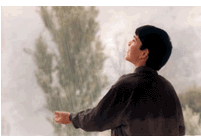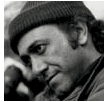 |
|
 |
 |
 |
 |
 |
 |
 |
 |
 |
 |
 |
 |
 |
1999 / Iran-Japan / Color / 85min.
| * 2000 | Bangkok Film Festival Golden Elephant |
| * 2000 | Montreal World Film Festival |
|
 |
|
 |
[SYNOPSIS]
At the school in a village in the northern Iran where it rains most of the year, rain is blowing in from the broken window in one of the classrooms.
Reza, a student who has been transferred from a dry region is entranced by the rain and does not heed the admonitions addressed to him. The teacher finally gives in and allows him to go outside and gaze at the rain to his heart's content.
Outside the classroom, there is another boy, Koichk, whom the assistant principal is scolding. He had broken the window two weeks ago and would not be allowed to take classes until he had compensated for the damage. Now he is being told that if the window is not fixed by tomorrow, he will be expelled from the school. Koichk has asked his father countless times to pay for the damage, but father refused because he could not afford it.
On the way home from school, the transfer student Reza kindly manages to borrow from his father the money for the glass. Koichk goes to the shop by himself but does not know the measurement of the window. The sympathetic owner of the shop helps him.
Barely holding onto the newly acquired glass, Koichk heads for the school amidst a terrible storm with a significant difficulty while the wind is blowing hard and the willow trees are swaying uncontrollably.
He finally arrives at the school only to face another problem: how is he, a short boy, going to fit the glass up in the window frame. His quandary continues...
[COMMENTARY]
WILLOW AND WIND is a simple story about a boy who is harshly told by his teacher to fix a window he has broken. The plot follows his process of undertaking the task. Every step along the way, there are obstacles to be overcome. Adding to his troubles are the callus and uncooperative attitudes of the adults and all the disadvantages he bears as a child. He has no money, no form of transportation, is disorganized and short. Films in which children play the lead seem familiar in the Iranian film industry. Films such as THE BOOTS, TICK TACK, and SACK OF RICE, directed by Mohammad Ali Talebi, all shown at the Focus on Asia Fukuoka Film Festival and the Iran Film Festival all share a similar suspense.
WILLOW AND WIND could have been just another Iranian child's film, were not for its unusual structure. For the first ten minutes, the main character, Koichk, does not appear. As the film opens, another child, a transfer student from a dry part of the country gazes curiously at the rain, reaching out through the broken pane to touch the rain drops.
Although it is the transfer student's behavior which prompts the teacher to make Koichk fix the window, the same student is eager to offer his help. The transfer student's face, drenched from the rain, aglow with curiosity, steals the opening scenes. His expression is so evocative, we might expect the story to revolve around him. This may be because Abbas Kiarostami's script can also be understood as a film in which the wind and the rain are the true main characters. There is no music, perhaps because the sound of the wind and the rain are music enough.
The wind is depicted in many guises. The white windmills at the power station the students visit, spin gently. Yet for Koichk, distressed by his inability to provide the shop owner with the exact measurement of the pane, the wind howls ever more ominously. Outside, the trees sway furiously in the wind. The wind tears through the pages of the book Koichk uses to carry the pane, blocking his sight, as he stumbles back to school. The pane is too large for the boy to hold, and the wind nearly blows it out of his hand. When it starts to rain again, leaves stick to the glass.
Compared to the slightly sentimental TICK TACK and SACK OF RICE, WILLOW AND WIND is rather cruel. The moment of tragedy is revealed only through the boy's face and an alarming sound. Because the director intentionally deprives us of the catharsis of the shattering glass, the boy's pain and loss echo all the more deeply. As the boy stands desolate, the wind relentlessly blows down the school corridor. The wind never subsides, not even in the final scene. But the beauty of the dusk, and the silhouette of the boy against the orange sky provide a hint of hope, if not anticipation, reminiscent of the last scenes of Kiarostami's AND LIFE GOES ON... and UNDER THE OLIVE TREES.
The film was photographed by Farhad Saba, who also shot Kiarostami's WHERE IS THE FRIEND'S HOME? Changie Saiyad, known for his work on AND LIFE GOES ONE , participated as sound editor. |
 |
by Hiroko MATSUDA
|
The Message from the director :
As everything in life must eventually come to an end, so has WILIOW AND WIND, which is finally completed. The friendship that I saw grow over the course of the film production, however, is deeply inscribed in my heart. Director Kiarostami, who wrote the script; Saba, who shot the film; Alireza Shojanoori and Mohamad Mehdi Dadgou, the producers; those amateur actors and the residents of the Lavieh village; cool autumn breeze brushing through the olive woods...All these dear memories still linger within me.
I used to make calls to Director Kiarostami with my mobile phone from the depths of the forest where I was immersed in peaceful tranquility that surrounded the prairie; only the chirping of wild birds were to be heard. I would speak to him about the scenes in the film, beauty of nature, and whatever it was that I was feeling at the time. Director Kiarostami always had willing ears for me, encouraged me in my making of WILLOW AND WIND, and kept on supporting me to the end.
We had to travel to some far away villages for this film. It is most fortunate that I get to share with all of you the poetic life among the nature that I experienced. Wind and rain, to walk to be one with wind and rain for even just one moment...it is worth living for. |
 |
 |
 |
 |
|
Mohammad Al Talebi, director :
Born in Tehran in 1958, he became a member of Institute for Intellectual Development of Children and Young Adult with a drama department and studio founded by Abbas Kiarostami at the age of ten. There he studied painting, theater, fiction writing, music and filmmaking. He then entered Faculty of Dramatic Arts and majored in Film and TV directing. He produced over ten short films for children during his university years. He proceeded to work for TV network and write more than fifty short programs and documentaries.
| 1984 : | CITY OF MICE |
| 1985 : | THE FINISHING LINE |
| 1986 : | THE WILDERNESS |
| 1987-89 : | THE PRIMROSE (series) |
| 1992 : | THE BOOTS |
| 1994 : | TICK TACK |
| 1998 : | SACK OF RICE |
Staff :
Director : Mohammad Ali Talebi
Screenwriter : Abbas Kiarostami
Producers : Mohamad Mehdi Dadgou, Makoto Ueda (NHK)
Associate Producer : Keiko Iino (NHK ENTERPRISES 21,INC)
Director of Photography : Farhad Saba
Editor : Sohrab Mirsepacy
Cast :
Koichk Pour : Hadi Alipour
Reza Ardakani : Amir Janfada
|
|
|





